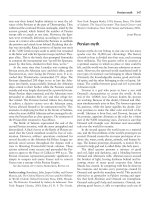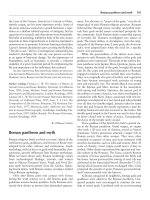Encyclopedia of world history (facts on file library of world history) 7 volume set ( PDFDrive ) 765
Bạn đang xem bản rút gọn của tài liệu. Xem và tải ngay bản đầy đủ của tài liệu tại đây (80.65 KB, 1 trang )
Five Dynasties of China
Iranbooks, 1997; Ferdowsi, Abolqasem. Shahnameh: The
Persian Book of Kings. Trans. by Dick Davis. Washington,
D.C.: Mage Publishers, 2006; Ferdowsi, Abu’L-Qasem. The
Shahnameh: (The Book of Kings). Ed. by Djalal KhaleghiMotlagh. Costa Mesa, CA: Mazda Publishers, 1997; Robinson, B. W. The Persian Book of Kings: An Epitome of the
Shahnama of Firdawsi. London: Curzon Press, 2002; Shahbazi, A. Shapur. Ferdowsi: A Critical Biography. Cambridge,
MA: Harvard University Press, 1991.
Rafis Abazov
Five Dynasties of China
The great Tang (T’ang) dynasty, founded in 618, was
wrecked by the Huang Zhao (Huang Ch’ao) Rebellion
that lasted between 875 and 884. It was put down only
with the help of regional warlords and Turkic allies (the
Turks who lived to the north of China were called Shatou), who retained power. In 907 a Shatou chief slaughtered the last Tang emperor and most members of the
Tang imperial family and proclaimed himself emperor of
the Later Liang dynasty.
Thus began the Five Dynasties Era, 907–960. It was
also called the Five Dynasties and Ten States Era, because
none of the Five Dynasties controlled lands beyond the
Yellow River plains of northern China whereas central
and southern China were ruled by 10 regional states,
each occupying about one province in that region. Later
historians did not give any of the Ten States the status
of a legitimate “dynasty” which succeeded one another
throughout Chinese history. The Five Dynasties were
1.
2.
3.
4.
5.
Later Liang (16 years, 907–923, three rulers)
Later Tang (T’ang) (13 years, 923–936, four rulers)
Later Jin (Chin) (10 years, 936–946, two rulers)
Later Han (three years, 947–950, two rulers)
Later Zhou (Chou) (nine years, 951–960, three rulers)
The first and last of the five were ruled by Han Chinese families; the remaining three were headed by men of
Turkic tribes, but who were largely Sinicized. For example the Later Tang rulers had served the Tang dynasty as
provincial governors and had been bestowed with the
Tang imperial surname Li. All five dynasties were founded by military adventurers, and within each dynasty,
family members or rivals assassinated many rulers. The
wars and rebellions that ended the Tang dynasty had so
devastated Chang’an (Ch’ang-an) that it would never
be China’s capital again. The center of political power
123
would shift eastward from Shaanxi (Shensi) province,
which was the cradle of Chinese civilization, to Henan
(Honan) province, where both Luoyang (Loyang) and
Kaifeng (K’ai-feng) (then called Bian or Pien) were
located. Both cities were capital of some of the dynasties
during this era, Luoyang because of its historic importance. Kaifeng is east of Luoyang, also on the southern
side of the Yellow River, and was easily accessible by
roads and the Grand Canal. It would remain the capital under the Song (Sung) dynasty, between 960 and
1126. However Kaifeng was without natural bulwarks
and was thus vulnerable to attacks. Chang’an became
the capital of the impoverished Shaanxi province and
its name was changed to Xi’an (Sian).
The wars and invasions that so disrupted northern
China in the ninth and 10 centuries also greatly diminished the long-entrenched leadership of the “eminent
clans” that had dominated political and social life since
the Han dynasty, because so many other members were
killed in the conflicts. This would result in a profound
social change and in the creation of a more egalitarian
society. Another factor contributing to growing egalitarianism is the invention of printing. Block printing to
produce books began in the seventh century (paper was
invented in China in the first century). It was during
the Five Dynasties, between 932 and 953, that the first
complete printed edition of the 11 Confucian Classics
(plus two supplementary works) totaling 130 volumes
was produced, under government sponsorship of four
dynasties. Luoyang, Kaifeng, and several cities in the
south became centers of a vibrant printing industry.
Cheaper printed books, as opposed to the expensive
hand copied ones, increased literacy and enabled sons
of middle-class families to compete in the state exams.
This fact also contributed to the breaking of the lock on
power by the “eminent clans.”
In contrast to the turmoil North China suffered from
the late Tang through the Five Dynasties, southern China
was relatively peaceful and continued to prosper. Many
great poets and painters of the era came from southern
China. This was a trend that would continue during the
next 1,000 years. During the Han and Tang dynasties the
frontier that had threatened China’s security had been
Central Asia, which included ancient lands called Sogdiana, Bactria, Transoxannia, and Ferghana in ancient
Western texts (modern Afghanistan, Tajikistan, Turkmenistan, Uzbekistan, Kirghizstan, and part of Kazakhistan) to the Caspian Sea. The threat had shifted by the
ninth century to a region called “Inner Asia” that extended from the Pacific Ocean westward for 3,000 miles to
the Pamir Mountains and from the Great Wall of China









